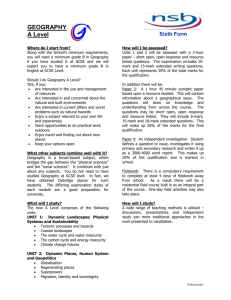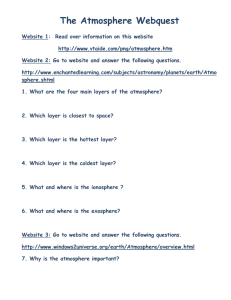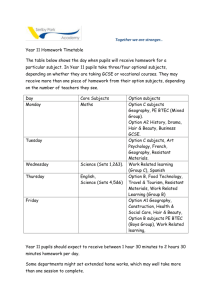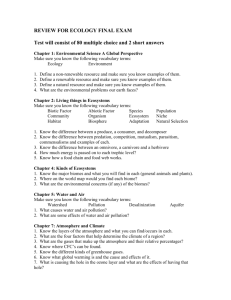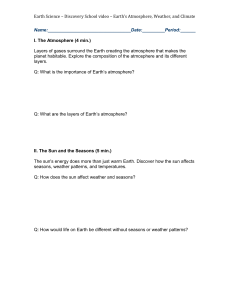(IGCSE) (Environmental Management) (0680/02) (unit 3): (Atmosphere) www.XtremePapers.com
advertisement
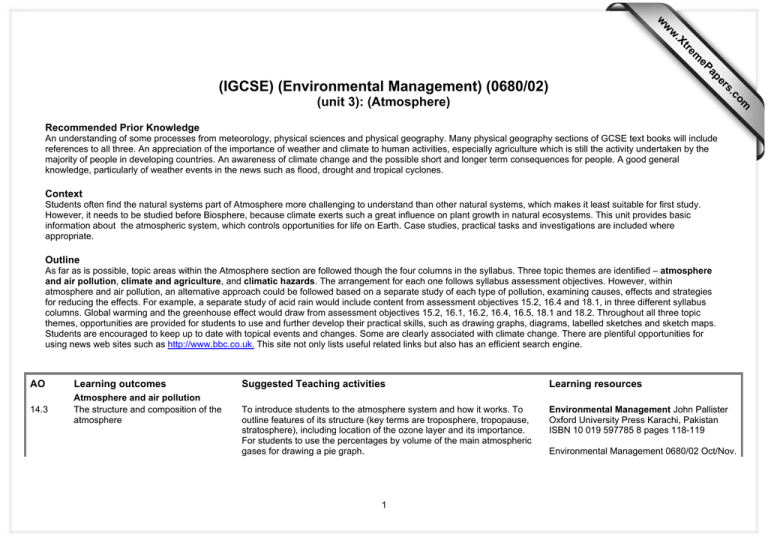
s er ap eP m e tr .X w w w om .c (IGCSE) (Environmental Management) (0680/02) (unit 3): (Atmosphere) Recommended Prior Knowledge An understanding of some processes from meteorology, physical sciences and physical geography. Many physical geography sections of GCSE text books will include references to all three. An appreciation of the importance of weather and climate to human activities, especially agriculture which is still the activity undertaken by the majority of people in developing countries. An awareness of climate change and the possible short and longer term consequences for people. A good general knowledge, particularly of weather events in the news such as flood, drought and tropical cyclones. Context Students often find the natural systems part of Atmosphere more challenging to understand than other natural systems, which makes it least suitable for first study. However, it needs to be studied before Biosphere, because climate exerts such a great influence on plant growth in natural ecosystems. This unit provides basic information about the atmospheric system, which controls opportunities for life on Earth. Case studies, practical tasks and investigations are included where appropriate. Outline As far as is possible, topic areas within the Atmosphere section are followed though the four columns in the syllabus. Three topic themes are identified – atmosphere and air pollution, climate and agriculture, and climatic hazards. The arrangement for each one follows syllabus assessment objectives. However, within atmosphere and air pollution, an alternative approach could be followed based on a separate study of each type of pollution, examining causes, effects and strategies for reducing the effects. For example, a separate study of acid rain would include content from assessment objectives 15.2, 16.4 and 18.1, in three different syllabus columns. Global warming and the greenhouse effect would draw from assessment objectives 15.2, 16.1, 16.2, 16.4, 16.5, 18.1 and 18.2. Throughout all three topic themes, opportunities are provided for students to use and further develop their practical skills, such as drawing graphs, diagrams, labelled sketches and sketch maps. Students are encouraged to keep up to date with topical events and changes. Some are clearly associated with climate change. There are plentiful opportunities for using news web sites such as http://www.bbc.co.uk. This site not only lists useful related links but also has an efficient search engine. AO Learning outcomes 14.3 Atmosphere and air pollution The structure and composition of the atmosphere Suggested Teaching activities Learning resources To introduce students to the atmosphere system and how it works. To outline features of its structure (key terms are troposphere, tropopause, stratosphere), including location of the ozone layer and its importance. For students to use the percentages by volume of the main atmospheric gases for drawing a pie graph. Environmental Management John Pallister Oxford University Press Karachi, Pakistan ISBN 10 019 597785 8 pages 118-119 1 Environmental Management 0680/02 Oct/Nov. AO Learning outcomes Suggested Teaching activities Learning resources 2005 Questions 1(a)(b) Past Paper 14.4 The balances which maintain the Earth's atmosphere as a mixture of gases To stress the importance of gases present in the atmosphere in very small volumes, notably carbon dioxide and water vapour. Environmental Management pages 119-120 14.1 The sun as an energy source; varying rates of surface insolation To ensure student understanding of the differences between short-wave and long-wave radiation. To define insolation, and for students to draw a labelled diagram to explain why rates of insolation decrease with latitude from Equator to Poles. To encourage students to study climate graphs in atlases for four or five cities in different latitudes and relate temperatures to latitude. Environmental Management pages 121-122 Longman Geography for GCSE page 84 14.2 The factors which contribute to solar heat balance of earth and atmosphere To make students aware of the differences between radiation, absorption and reflection of sun's rays. For students to show how each one operates by drawing a section through the atmosphere. Environmental Management page 120 15.1 Water, solar and wind as power sources To make the link back to alternative energy sources in 5.2 (Unit 1) for general advantages over fossil fuels, and to large dams in 8.1 (Unit 2). To focus here on how power can be obtained from the three named weather elements, and why production from each one (and potential for further use) varies greatly from country to country. For students to obtain statistics for energy production in the home country and show percentages in a pie or divided bar graph. To ask them to comment on the importance (now and in the future) of these alternative sources. Environmental Management pages 122-124 Longman Geography for GCSE pages 220 and 222-223 15.2 Use of the atmosphere as a dispersal medium for waste gases To study the human sources of smoke particles and other solid particles released into the atmosphere and the reasons for their increase from factories and motor vehicles. To make a special study of what is released from vehicle exhausts burning fossil fuels. http://www.bbc.co.uk/renewableenergy Natural Economy 0670/02 May/June 2000 Questions 2(f)-(h) Oct/Nov. 2002 Question 2(g) Past Papers Longman Geography for GCSE pages 232233 Environmental Management page 127 Environmental Management 0680/02 Oct/Nov. 2005 Questions 1(d)-(f) Past Paper 2 AO Learning outcomes Suggested Teaching activities Learning resources 16.1 Human activities which alter the composition of the atmosphere and climate To concentrate here on pollution and climate. To give students a choice of cities famous for smog (such as Los Angeles, Mexico City, Santiago de Chile) for an investigation into physical and other local factors which make the smog worse, including temperature inversion. Then to study atmospheric pollution in general, to include other human activities such as deforestation and fossil-fuel burning electricity power stations, and what these release into the atmosphere. Environmental Management pages 127-128 Causes of atmospheric pollution To concentrate here on the four main greenhouses gases and their relative contributions to the greenhouse effect. To explain how the natural greenhouse effect works. To study statistics for average world temperatures for 100+ years which show that global warming is taking place. To obtain data about total cumulative carbon emissions, which students can use to draw a line graph. For students to investigate differences in amounts of carbon dioxide emissions between countries, and the reasons for them. Environmental Management pages 134-135 GCSE Biology D.G. Mackean John Murray pages 243-244 To study how and why people damaged the high level ozone layer by using CFCs. To make a special study of Antarctica where the thinning of the ozone layer was first discovered by scientists. Environmental Management pages 132-133 and page 136 http://www.bbc.co.uk/ozonehole 16.2 16.3 Damage to the ozone layer and links to atmospheric pollution Environmental Management 0680/02 Oct/Nov. 2005 Question 1(g) Past Paper Environmental Management 0680/02 May/June 2004 Questions 2(a)(b) Past Paper Environmental Management 0680/02 Oct/Nov.2005 Question 1(c) Past Paper 16.4 The effects of pollution on atmospheric conditions First to make a special study of acid rain, identifying sources of nitrogen oxides and sulphur dioxides (the main acid gases), and examining the effects (local, national and international) on trees, soils, water based ecosystems and people. Secondly, to examine the possible present and future effects of global warming on climate and people. To undertake an individual study of likely effects for the student's home country or world region. 3 Longman Geography for GCSE pages 232233 Environmental Management pages 129-131 and 136-138 http://www.bbc.co.uk/climatechange Natural Economy 0670/02 May/June 2000 Question 2(e) Nov. 2000 Questions 2(a)-(f) Environmental Management 0680/02 May/June 2004 Questions 2(a)(b) AO Learning outcomes Suggested Teaching activities Learning resources Past Papers 16.5 The implications of changes in the atmosphere and climate One approach is for students to draw and complete a large table to summarise changes and effects caused by humans. Students can be guided into the use of suitable headings such as 'causes', 'direct effects on the atmosphere', and 'other effects' for different pollution types – increasing smoke particles and exhaust fumes, increasing proportion of carbon dioxide, decreasing proportion of high level ozone. An alternative approach is to use 'human health' and 'loss of natural resources/food production' as headings, under which to study the combined effects of all the different types of pollution (after having previously been studied separately). Environmental Management page 125 18.1 Strategies to reduce atmospheric pollution and climatic change To examine strategies for tackling pollution – reduction in pollutant emissions from traffic in urban areas, reforestation instead of deforestation, energy production with lower carbon dioxide, sulphur and nitrogen emissions and replacements for CFCs Environmental Management pages 128-129 (urban air quality), 139-140 (greenhouse effect), 131(acid rain) and 133 (ozone layer damage) 18.2 The need for international action and changing attitudes to deal with the causes and consequences of the damage to the atmosphere To ask students to explain, based on work already done, why international solutions are needed for some types of atmospheric pollution (notably acid rain, damage to the ozone layer and global warming). To examine the main recommendations of the Montreal Protocol (1987) and the Kyoto Treaty (1997), and their relative success / failure. For students to research updates on tackling global warming (e.g. Bali Conference in 2008). Environmental Management pages 133 and 139 To begin by stressing the importance of accuracy when siting and reading weather instruments. To ensure that students understand how to take accurate measurements from thermometers, rain gauge, barometer, wind vane, anemometer and sunshine recorder. An opportunity might exist to visit to a local weather station to give students a practical experience. Environmental Management pages 141-144 Longman Geography for GCSE pages 8283 Environmental Management 0680/02 Oct/Nov. 2006 Question 2(a) Past Paper Natural Economy 0670/02 Oct/Nov. 2001 Questions 2(a)(b) May/June 2002 Questions 2(a)-(c) 14.5 Climate and agriculture How the elements of weather are measured, recorded and interpreted 4 Environmental Management 0680/02 May/June 2004 Questions 2(c)-(f) Past Paper AO Learning outcomes Suggested Teaching activities Learning resources Past Papers 14.6 Location of major climatic types and their main characteristics through interpretation of climatic graphs and maps To provide students with an outline guide for identifying the key elements of temperature and precipitation from a climate graph, such as months with the highest and lowest temperatures, annual range of temperature, months with highest and lowest precipitation, precipitation distribution during the year (all year, or wet and dry seasons). To use a climate graph for the home region first, as practice. Then to ask students to describe graphs the main characteristics of the six climatic types named in the syllabus from an atlas. To study the main locations for each type on an atlas map, noting down one or two examples of areas for each type. Environmental Management pages 146-150 Longman Geography for GCSE pages 8687 Natural Economy 0670/02 May/June 2002 Questions 1(a)-(c) Past Paper Atlas e.g. Philips' Modern School Atlas pages V-XII and 8 15.3 The interaction between climate and human activity Class activity – Brainstorm session How weather and climate affect people and work. To think first about ways in which they and their families are affected by weather and climate. Secondly, to identify types of work for which weather and climate are important factors and to explain how. To undertake a local / home region investigation of types of farming and how they are influenced by the region's climate. Environmental Management page 151 15.4 The different types and systems of farming To introduce students to the key terms used in the description of farming types and systems, to understand differences between crop and pastoral farming, intensive and extensive farming, and subsistence and commercial farming. To provide a grid of different farming types for students to identify whether the farming system is crop or pasture, intensive or extensive, subsistence or commercial. Longman Geography for GCSE page 170 Environmental Management page 152 15.5 The environmental, technological, economic and social factors which influence the distribution of different types and systems of farming To identify the different factors which influence farming systems, including environmental (climate, soils and relief), technological (investment in machinery and other inputs) and social (traditional way of life or paid workers). To study examples of two or three different farming systems to show relative importance of these factors. Environmental Management pages 152-155 Longman Geography for GCSE pages 180185 5 AO Learning outcomes Suggested Teaching activities Learning resources 15.7 The factors which influence the patterns of agricultural output and trade To identify the traditional pattern of world trade in agricultural products between developing and developed countries. To explain why it favours rich developed countries. To provide students with opportunities for practical tasks, such as drawing a line graph for world market price fluctuations in a commodities such as coffee or cocoa. Environmental Management pages 159-160 Longman Geography for GCSE pages 194195 15.6 New agricultural techniques which increase yields To begin with a discussion about why more agricultural output is needed. To outline how use of each of the five techniques named in the syllabus can increase agricultural yields. Environmental Management pages 156-157 17.2 The advantages and disadvantages of the 'green revolution' To begin with a definition of Green Revolution, emphasising the development of high yielding varieties of seeds (HYVs). To examine its successes and benefits at different levels – for individual farmers, for the economies of countries. Environmental Management pages 158-159 Longman Geography for GCSE page 181 GCSE Biology D.G. Mackean pages 211-212 http://www.indiaonestop.com/Greenrevolution 17.1 The impact of indiscriminate agricultural practices To focus separately on environmental and human impacts from the use of modern agricultural practices. To begin with a review of environmental impacts studied in earlier units, such as eutrophication in rivers and lakes, salinisation, and the negative consequences of dam building. To round it off with an outline introduction for impacts such as soil erosion studied in more detail in the next unit. To give students the opportunity to draw two comparative flow diagrams, one for rich farmers becoming richer after adopting new techniques, and a second for poor farmers, stuck in the poverty trap, and getting poorer. Environmental Management pages 160-162 19.1 Strategies for sustainable agriculture To begin by checking that students can apply the idea of sustainable development to agriculture. To introduce them to the concept of appropriate technology for small farmers in developing countries To demonstrate how each of the strategies named in the syllabus can be used to achieve this. To extend study for one or more them, such as how trickle drip irrigation can conserve irrigation water and decrease the risk of salinisation. Longman Geography for GCSE page 186 Environmental Management pages 163-164 To concentrate first on biomass, a long established power source – what it included, where it is much used and why is it important. To reinforce the Environmental Management pages 165-166 Longman Geography for GCSE page 221 19.2 Harvesting energy from living resources to provide power 6 Environmental Management 0680/02 Oct/Nov. 2004 Questions 2(b)-(d) Past Paper AO Learning outcomes Suggested Teaching activities links with energy studies in previous units, students can be asked to draw a chart divided into four to summarise the economic and environmental advantages and disadvantages of using biomass compared with a fossil fuel such as oil. To follow this up with a study of biofuels, increasingly important as a renewable source of energy, but also increasingly controversial. There is an opportunity for students to make a special study of Brazil, the world leader in use of ethanol for transport (made from sugar cane). 14.7 16.6 18.3 Climatic hazards 'Climatic hazards' (extremes of weather: causes and occurrence To begin with definitions of 'natural hazard' and 'climatic hazard'. To link back to other hazards already studied in the lithosphere and hydrosphere units and to review earlier studies of floods and drought, updating in the light of new events (where necessary). To concentrate here on the causes and occurrence of tropical cyclones. The impact of climatic hazards on human communities To give students advice on how to organise their study of impacts, by separating out immediate effects (loss of life and physical damage), from short-term effects (dangers to health) and longer-term effects (loss of production). Strategies to reduce the negative impact of climatic hazards To outline general strategies for reducing the impacts of hazards using the two headings – prevention before the event, and relief after it. To ask students to apply the general strategies to the individual climatic hazards. There is the opportunity for students to undertake individual investigations of climate hazards that affect their home country or world region. To guide their work by suggesting headings such as 'where' (areas most at risk), 'when' (at what time of year), 'causes', 'negative impacts in the past' and 'strategies in place to reduce effects on people from future hazards'. 7 Learning resources http://www.cbsnews.com/stories/2006/03/13/t ech/main1394254.shtml Environmental Management pages 167-169 http://www.metoffice.gov.uk/tropicalcyclones Environmental Management 0680/02 May/June 2006 Question 2(d) Oct/Nov. 2006 Questions 2(b)(c) Past Papers Environmental Management pages 169-172 Natural Economy 0670/02 Nov. 2001 Questions 2(c)-(e) May/June 2002 Question 2(d) Past Papers Environmental Management pages 169-171 Environmental Management 0680/02 May/June 2006 Question 1(d) Oct/Nov. 2006 Question 2(d) Past Papers AO Learning outcomes Suggested Teaching activities 8 Learning resources
